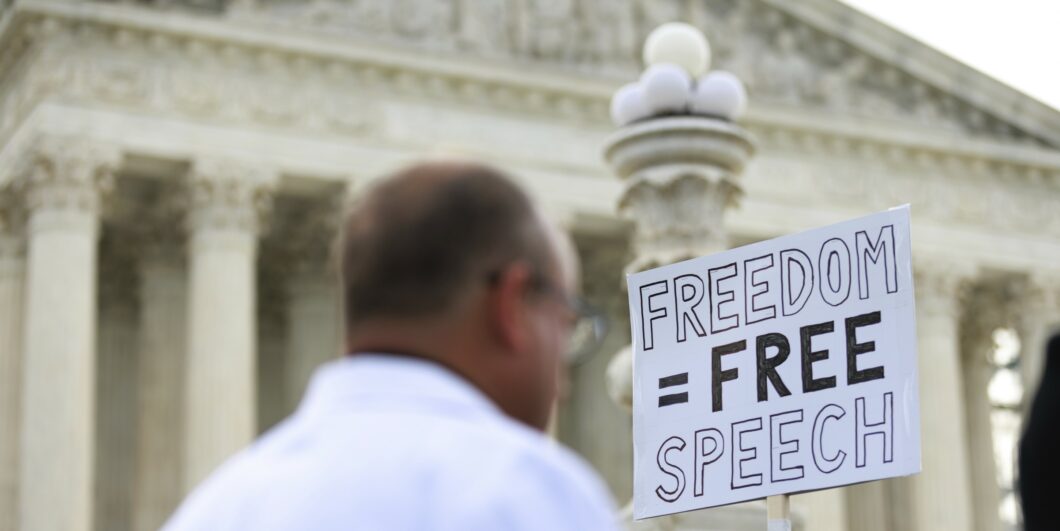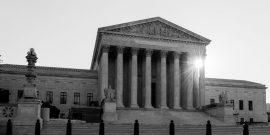Murthy’s Maddening Modesty
The long-awaited Supreme Court case concerning social media culminated not with a bang but with a whimper. Murthy v. Missouri ruled on the Biden Administration’s efforts to shape social media platforms’ content-moderation policies. But the Court ruled not on the case’s merits but on standing. Writing for a 6–3 majority, Justice Amy Coney Barrett reasoned that the plaintiffs—two states and several individuals—failed to establish the likelihood of future injury required to sue for a forward-looking injunction.
Nonetheless, Murthy’s sound and fury signifies a great deal. The case’s protracted saga, and even the Supreme Court’s sidestep, reveals much about both the proper workings of America’s constitutional cosmos and the derangements that today afflict it. That the federal officials’ attempts to deplatform disfavored political views vandalized American free speech seems clear to everybody except those who prefer those views to be eradicated.
James Madison and his compatriots considered overreach to be inevitable. Therefore, they devised constitutional machinery to disincentivize and thwart it, designing an adversarial institutional ecosystem that outright encourages friction. As Madison emphasized in Federalist #51, the Constitution gives to “each department the necessary constitutional means and personal motives to resist encroachments of the others.” Intra-governmental squabbling constitutes a feature, not a bug, of the system.
If one recognizes the Administration’s abuses and the need for redress, questions still arise regarding what duties to restore good governance attach to Congress, the courts, and private actors.
Many conservative commentators counted on the High Court to remedy every ill Murthy highlighted. Such a deus ex machina falls outside the judiciary’s remit, however. From close coordination on public health questions (e.g. the Center for Disease Control’s (CDC) relationship with Facebook) to private harangues and explicit public threats (e.g., the conduct of the White House staff), the influence campaigns spanned years, multiple federal agencies, and multiple social media platforms. Some efforts unquestionably were coercive. Many were not as a legal matter, which does not mean they were not corrupt or censorial in intent.
A more limited ruling could have done much good. The Court has yet to apply offline jawboning precedents such as Bantam Books v. Sullivan (1963) and National Rifle Association (NRA) v. Vullo (2024) to government’s communications with social media. These two cases, respectively, dealt with coercive efforts against book publishers and NRA-affiliated financial institutions. In both, the Court delineated between persuasion and coercion. In Murthy, it could have attempted to create some test, however imprecise and insufficient, to extend the principles of Bantam Books and Vullo to the myriad new difficulties the digital world presents.
An understanding of Murthy’s idiosyncrasies, and their larger implications, emerges not from either Barrett’s majority opinion or Justice Samuel Alito’s fiery dissent—but from both, read in conjunction. (As its author has not spent one day in law school, this essay will dodge the Supreme Court’s dodge and decline to analyze the intra-Court debate over standing doctrine, a subject that baffles even experienced lawyers.)
The majority took head on what too many Murthy enthusiasts have ignored: The claims the plaintiffs alleged, and the lower courts’ opinions sanctioned, often lacked factual accuracy and legal validity. As Justice Barrett put it in a pointed footnote, “The Fifth Circuit relied on the District Court’s factual findings, many of which unfortunately appear to be clearly erroneous.” Moreover, Barrett noted that the social media platforms in question had cracked down on right-wing content well before the Biden Administration began exerting significant pressure. Platforms’ taste for censorship complicates efforts to link discrete government communications to discrete instances of deplatforming. Barrett also argued, “On several occasions, various platforms explained that White House officials had flagged content that did not violate company policy.” The case’s district judge noted this dynamic, too, reporting that “the FBI had a 50% success rate regarding social media’s suppression of alleged misinformation.” Such numbers do not indicate that platforms had become categorically subservient to the government’s whim, as the district judge and many conservative commentators have suggested.
If Barrett picked apart the plaintiffs’ worst arguments, Alito drove home their best. He recounts at length the White House’s torrential correspondence with platforms, its domineering tone, and its explicit public threats of regulatory reprisal should platforms fail to comply. Irrespective of whether the Court manages to trace individual communications to the plaintiffs’ deplatforming, the Biden Administration’s pressure campaign, in aggregate, surely caused social media to moderate content more severely. “The message was delivered piecemeal by various officials over a period of time in the form of aggressive questions, complaints, insistent requests, demands, and thinly veiled threats of potentially fatal reprisals,” he stated. “But the message was unmistakable, and it was duly received.”
However, Alito’s incisive identification of coercion with respect to the White House’s communications would not likely have extended to all the other defendant agencies. As Alito noted, officials may, to a point, lobby private actors—even on speech-related matters. “An official may forcefully attempt to persuade,” he wrote. The challenge lies in categorizing border-line communications and influence campaigns into permissible and impermissible.
Many efforts the Murthy plaintiffs painted as coercive were, simply put, not. Siding with the plaintiffs—as to matters both of law and of personal sympathy—the district-court judge committed this error incessantly. The Fifth US Circuit Court of Appeals, which scratched its head at much of the district court’s injunction, applied sound principles to the case’s particulars in a somewhat confused fashion. (Consider its analysis regarding the Cybersecurity and Infrastructure Security Agency). As noted elsewhere, the social media platforms often solicited or welcomed the official input. In certain instances, with respect to the CDC, the appeals court enjoined the government from assisting social media, which it deemed impermissible “significant encouragement.” This logic could—if not clarified and cabined, at least—bar private actors from soliciting and incorporating into their business models the advice of government agencies.
No judge’s opinion can define either systematically or precisely at what point of intensity officials’ legitimate persuasive efforts become unconstitutionally coercive.
No judge can declare constitutional speech to be unconstitutional without cosplaying as a legislator. The Constitution tasks the judiciary with interpretation to exercise “judgement,” not “force” or “will,” as Alexander Hamilton put it in Federalist #78. Judges cannot proscribe lawful speech—however awful—nor can they enjoin social media from adopting draconian content-moderation policies. However healthful for the body politic, any legally plausible ruling on the merits for the plaintiffs would have proved disappointing to them and their most fervent supporters. Notwithstanding its substantial likely benefits, any such ruling would have left entry points through which future efforts at circuitous censorship could slink.
But many conservatives fail to grasp that even a maximalist (and improper) finding for the Murthy plaintiffs would have left much necessary policymaking undone. No judge’s opinion can define either systematically or precisely at what point of intensity officials’ legitimate persuasive efforts become unconstitutionally coercive. No opinion can define precisely what words, or what number of emails sent in the same week with the same request, qualify as coercive. Any judge-made standard would leave gaping holes through which future speech suppression might proceed. This is particularly so concerning fact patterns like the one alleged in Murthy, involving many communications that would not, in isolation, violate the First Amendment, but in aggregate, or with additional context, likely would.
Constitutional does not mean good. It can, at times, mean quite the opposite. Officials can deploy permissibly persuasive means for ill. Here, the Biden Administration labored to remove from public debate hotly contested matters of great import. Whether a free society can permit the state thus to manipulate private opinions is a question distinct from the First Amendment’s letter and jurisprudence.
So, the question arises again. By which means can America ameliorate its political ills? What duties attach to whom?
Although hopelessly waterlogged today, the Article I branch, primus inter pares, alone possesses the power necessary to design and dictate policy. National Review’s Charles C. W. Cooke writes that the Supreme Court, “while important … is not supposed to be at the center of the federal apparatus and … when it demurs, there are other options available to the people.” In fact, Congress ought not to have waited, hoping judges would solve the controversies Murthy raised. It shirked its duty to act first and to act vigorously.
In the American system, Congress serves as the engine of policymaking. It has legislative means to ameliorate these problems. It could enact a broad limitation on officials—including its own members — seeking to curtail online speech. Unlike the judiciary, Congress can enact law that extends limits on government officials’ speech past the First Amendment’s scope. Such legislation would do much good but would not suffice, due to many of the difficulties that attend judicial attempts to articulate such standards. It would necessarily include carveouts for national security, law enforcement, and other legitimate government activities such as exposing fraudulent impersonators of officials, almost certainly leaving latitude for future misbehavior.
Therefore, besides enacting such a restriction, Congress would have to create a robust disclosure regime requiring that the government publicize all official communications concerning social media content moderation, excepting absolutely necessary redactions only. Such a measure could not only facilitate lawsuits against violative conduct but, by allowing journalists and citizens an easy means to review officials’ censorial escapades, create political incentives against abuse. This disclosure regime should subject all wayward officials to harsh punishments.
Conservatives’ anger at the Court’s ruling—or its intensity, at least—absolves Congress of its constitutional, moral, and political duties. They might rejoin that Congress lacks the institutional will to act. This resembles tut-tutting a drunk uncle who has blacked out again before 3 p.m. on Thanksgiving Day; the fact that dysfunctional behavior is expected renders it no less inexcusable.
However, the American people must look still further upstream and follow the water back to what Hamilton called the “pure, original fountain of all legitimate authority”: themselves. It is the American people who elect representatives, and tolerate bureaucrats, who suppress speech. It is the American people who, as the governed, have ratified congressional atrophy and impotence. And while it is the subset of the American people who operate social media platforms that have decided that (albeit constitutionally protected) suppression—rather than open discourse—must umpire public debates, too many of the American people support the platforms’ chosen course. As speech fora, platforms ought to concern themselves primarily with facilitating and defending free speech—not maximizing so-called trust and safety. Free speech requires defense both in law and in culture.
The American people’s failures have occurred on a bipartisan basis. While Murthy deals specifically with the Biden Administration, officials in the Trump administration and congresspeople of both parties have cajoled and threatened social media. And yet, until it disadvantages their tribe, the American people have yawned. A republic cannot live by judges or by parchment barriers alone. It requires a citizenry dedicated to keeping it.
Murthy’s saga continues. The plaintiffs likely will adjust their complaints and carry on. But the case’s challenge to Congress and the American people seems vibrant and clear. It is nothing less than a challenge to revitalize the American constitutional order.



